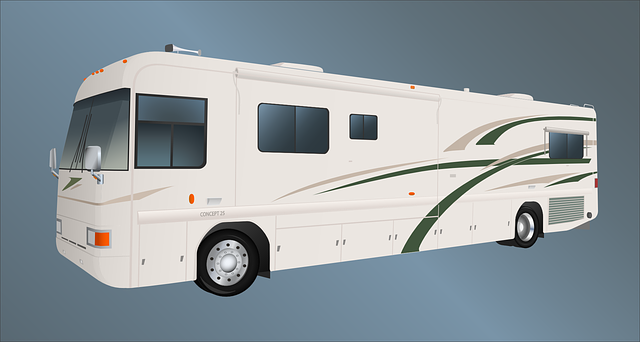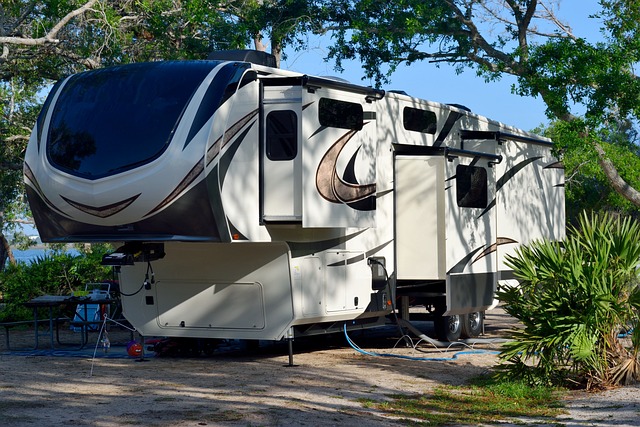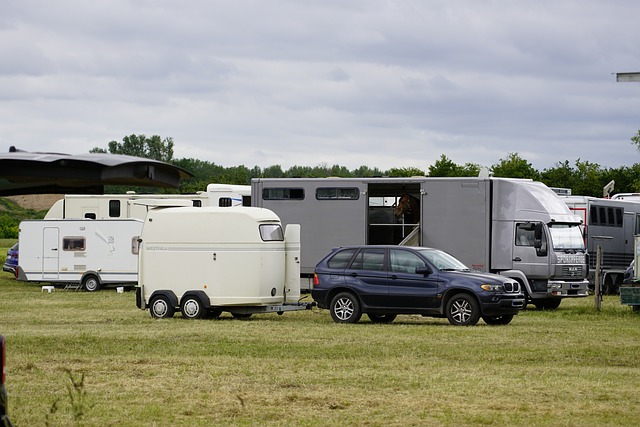When embarking on an RV trip, it's crucial to have a reliable power source, especially when off-grid. RVs are typically equipped with deep-cycle batteries designed for managing extended energy use. These batteries work in tandem with solar panels, which are indispensable during boondocking or dry camping, to maintain power flow. The success of this setup depends on the size and quality of your solar panels, their positioning on the RV, the efficiency of your charge controller, and the batteries' capacity. Factors like solar irradiance, panel angle, and temperature influence performance. To maximize energy generation and storage, it's recommended to match your solar panels with your RV battery system's amp-hour rating. Monocrystalline solar panels are often preferred for their high efficiency and durability. For instance, the Eco-Worthy 100W 12V Solar Panel is a robust choice for RVers. When installing solar panels, choose a location on your RV that receives ample sunlight, and ensure a secure mount with no obstructions. Select a solar panel model that meets your energy needs and available space; a 100-watt panel can provide around 3 to 5 amps per hour under ideal conditions. Safety and proper installation are key—make sure all connections are waterproofed, wiring is secure, and the panels are level to prevent water damage. Regular maintenance of your RV batteries and monitoring their charge status will ensure their health and longevity, making solar power a sustainable and cost-effective energy solution for your RV travels.
Exploring the sun’s power for your RV’s energy needs can be both a sustainable and practical choice. This article delves into the integration of solar panels with RV battery systems, guiding you through the top solar panel options tailored for RVers. From efficiency to durability, we compare the best models on the market, ensuring your investment serves you reliably under the open sky. With a detailed installation guide and tips to maximize your RV batteries’ lifespan using solar power, your journey off the grid is set to be powered by clean, renewable energy.
- Understanding RV Battery Systems and Solar Panel Integration
- Top Solar Panels for RVs: A Comparison of Efficiency and Durability
- Installation Guide: Setting Up Your Chosen Solar Panel for Optimal RV Battery Charging
- Maximizing the Lifespan of Your RV Batteries with Solar Power
Understanding RV Battery Systems and Solar Panel Integration

When embarking on an RV adventure, understanding your vehicle’s battery system and its integration with solar panels is crucial for maximizing energy autonomy. Typically, RVs are equipped with deep-cycle batteries designed to handle the demands of prolonged discharge that off-grid living entails. These batteries store energy from your RV’s electrical system or from an external power source, which can be depleted as you use appliances and electronics. To maintain a consistent power supply, especially when boondocking or dry camping without access to standard hookups, integrating solar panels becomes a prudent choice.
Solar panels for RVs are tailored to capture sunlight and convert it into electricity that can be used immediately or stored in the RV’s battery system. The efficiency of this integration depends on several factors, including the size and quality of the solar panels, their placement on the RV, the efficiency of the charge controller, and the capacity of the batteries. Factors such as solar irradiance, panel angle, and temperature also play significant roles in the system’s performance. To optimize this setup, it’s advisable to select solar panels that align with the RV battery’s amp-hour rating; this ensures a harmonious energy generation and storage process. By understanding the interplay between RV batteries and solar panel integration, travelers can significantly enhance their self-sufficiency and enrich their off-grid experiences. Choosing the right components and installing them correctly are key to harnessing the power of the sun for your RV’s energy needs.
Top Solar Panels for RVs: A Comparison of Efficiency and Durability

When it comes to sustaining an RV’s power needs while on the road, solar panels are a highly efficient and environmentally friendly solution. For RVers, the top solar panels must balance high efficiency with durability, as they face the dual challenges of harsh weather conditions and the need to generate significant energy from limited space. Among the most robust options for RV battery charging, monocrystalline solar panels stand out due to their superior conversion efficiency compared to polycrystalline or amorphous panels. This efficiency ensures that even a relatively small array can harness a substantial amount of solar energy, which is crucial for powering various appliances and maintaining battery charge levels.
Moreover, the durability of these panels cannot be overstated; they are built to withstand the elements, with sturdy frames and materials designed to resist wind and snow loads, as well as exposure to intense sunlight and varying temperatures. Flexible solar panels represent another category that is particularly well-suited for RVs due to their lightweight and adaptable nature, making them less prone to damage from road vibrations or sudden movements. Models such as the Eco-Worthy 100W 12V Solar Panel are not only efficient but also come with a strong frame that can handle the rigors of RV travel without compromising energy output. When selecting the best solar panels for your RV battery needs, consider both the immediate efficiency and the long-term durability to ensure your setup remains reliable, regardless of where your travels take you.
Installation Guide: Setting Up Your Chosen Solar Panel for Optimal RV Battery Charging

When integrating solar panels into your RV for optimal battery charging, careful planning and execution are key. Begin by assessing your RV’s roof to determine the best location for maximum sunlight exposure throughout the day. Ensure that the area is clear of obstructions and has a sturdy surface suitable for mounting. Select a solar panel model that aligns with your energy needs and the space available; typically, a 100-watt solar panel can generate approximately 3 to 5 amps per hour under optimal conditions.
Before installation, read through the manufacturer’s manual to familiarize yourself with safety precautions and specific instructions. You will need to gather the necessary tools and materials, which often include a solar charge controller, mounting brackets or rails, a knife or saw for cutting Dicor lap sealant, a drill with bits for creating holes, an appropriately sized wrench for panel bolts, and connectors for electrical wiring. Properly secure the panel to the roof with the mounting hardware, ensuring it is level to prevent water pooling and potential leaks. Connect the solar panel to your RV’s battery system via the charge controller, making sure all electrical connections are waterproofed to maintain system integrity. Use the sealant around the edges of the panel for added protection against the elements. Finally, double-check all wiring and connections for tightness and correctness. With these steps followed diligently, your RV solar panel setup will provide an efficient and sustainable power source for your RV battery, enhancing your off-grid experiences.
Maximizing the Lifespan of Your RV Batteries with Solar Power

When integrating solar power into your RV’s energy system, a key consideration is maximizing the lifespan of your RV batteries. Solar panels can significantly reduce the strain on your batteries by providing a consistent charge, especially during extended off-grid stays. The efficiency and capacity of RV batteries, such as deep cycle lead acid or lithium ion variants, are directly influenced by the quality and quantity of solar energy they receive. To optimize battery health, it’s crucial to select solar panels that align with your RV’s power needs; this ensures a steady supply of electricity to recharge the batteries without overcharging them. Additionally, implementing a charge controller tailored to your solar array and RV battery type is essential for maintaining optimal charging levels and preventing potential damage from voltage spikes or drops. Regular maintenance, such as keeping the batteries clean, topped up with distilled water if necessary, and monitoring their state of charge, complements the use of solar power to extend their operational life. By carefully selecting and installing a solar panel setup, you can enhance the performance and longevity of your RV batteries, making your solar investment both cost-effective and sustainable over time.
When integrating solar panels into your RV for battery charging, selecting the right system is key to harnessing solar power effectively. This article has outlined the essential aspects of RV battery systems and provided a detailed comparison of top-performing solar panels for RVs. With insights into efficient and durable options, paired with an installation guide tailored for RVers, you’re well-equipped to set up your solar panel array. By following these guidelines, you can maximize the lifespan of your RV batteries and rely more on renewable energy sources during your travels. Remember to consider the specific needs of your RV setup when choosing a solar panel system, ensuring seamless integration and optimal performance for your adventures on the road.
